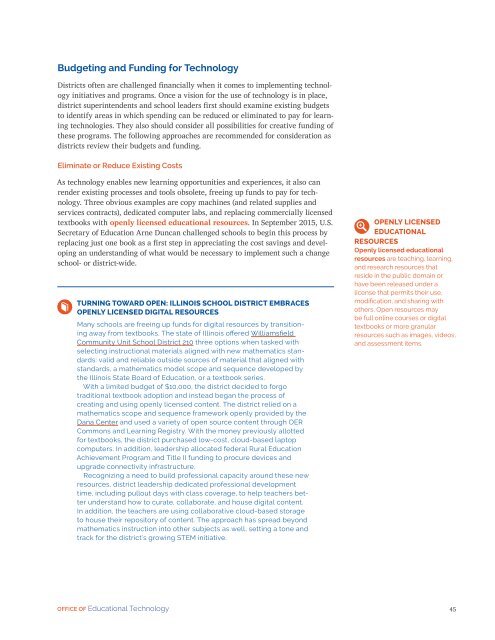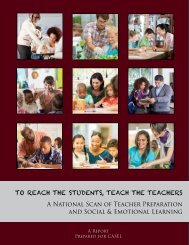Future Ready Learning
7m3sdJ
7m3sdJ
Create successful ePaper yourself
Turn your PDF publications into a flip-book with our unique Google optimized e-Paper software.
Budgeting and Funding for Technology<br />
Districts often are challenged financially when it comes to implementing technology<br />
initiatives and programs. Once a vision for the use of technology is in place,<br />
district superintendents and school leaders first should examine existing budgets<br />
to identify areas in which spending can be reduced or eliminated to pay for learning<br />
technologies. They also should consider all possibilities for creative funding of<br />
these programs. The following approaches are recommended for consideration as<br />
districts review their budgets and funding.<br />
Eliminate or Reduce Existing Costs<br />
As technology enables new learning opportunities and experiences, it also can<br />
render existing processes and tools obsolete, freeing up funds to pay for technology.<br />
Three obvious examples are copy machines (and related supplies and<br />
services contracts), dedicated computer labs, and replacing commercially licensed<br />
textbooks with openly licensed educational resources. In September 2015, U.S.<br />
Secretary of Education Arne Duncan challenged schools to begin this process by<br />
replacing just one book as a first step in appreciating the cost savings and developing<br />
an understanding of what would be necessary to implement such a change<br />
school- or district-wide.<br />
TURNING TOWARD OPEN: ILLINOIS SCHOOL DISTRICT EMBRACES<br />
OPENLY LICENSED DIGITAL RESOURCES<br />
Many schools are freeing up funds for digital resources by transitioning<br />
away from textbooks. The state of Illinois offered Williamsfield<br />
Community Unit School District 210 three options when tasked with<br />
selecting instructional materials aligned with new mathematics standards:<br />
valid and reliable outside sources of material that aligned with<br />
standards, a mathematics model scope and sequence developed by<br />
the Illinois State Board of Education, or a textbook series.<br />
With a limited budget of $10,000, the district decided to forgo<br />
traditional textbook adoption and instead began the process of<br />
creating and using openly licensed content. The district relied on a<br />
mathematics scope and sequence framework openly provided by the<br />
Dana Center and used a variety of open source content through OER<br />
Commons and <strong>Learning</strong> Registry. With the money previously allotted<br />
for textbooks, the district purchased low-cost, cloud-based laptop<br />
computers. In addition, leadership allocated federal Rural Education<br />
Achievement Program and Title II funding to procure devices and<br />
upgrade connectivity infrastructure.<br />
Recognizing a need to build professional capacity around these new<br />
resources, district leadership dedicated professional development<br />
time, including pullout days with class coverage, to help teachers better<br />
understand how to curate, collaborate, and house digital content.<br />
In addition, the teachers are using collaborative cloud-based storage<br />
to house their repository of content. The approach has spread beyond<br />
mathematics instruction into other subjects as well, setting a tone and<br />
track for the district’s growing STEM initiative.<br />
OPENLY LICENSED<br />
EDUCATIONAL<br />
RESOURCES<br />
Openly licensed educational<br />
resources are teaching, learning,<br />
and research resources that<br />
reside in the public domain or<br />
have been released under a<br />
license that permits their use,<br />
modification, and sharing with<br />
others. Open resources may<br />
be full online courses or digital<br />
textbooks or more granular<br />
resources such as images, videos,<br />
and assessment items.<br />
OFFICE OF Educational Technology<br />
45



